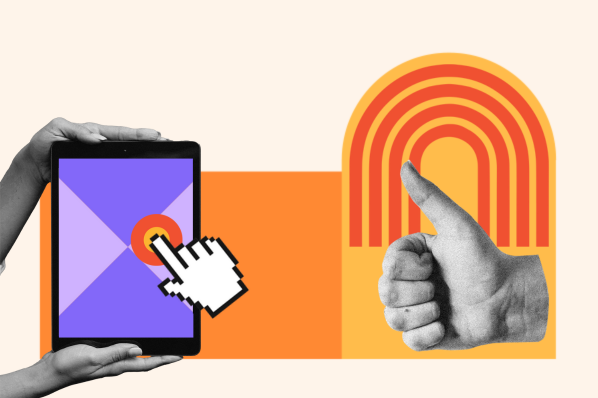While you don’t need to be besties with your users, you should get to know them on a level that goes deeper than vague labels like “working mom” or “recent college grad.” That's where user personas come in. In this post, I'll show you how to create detailed UX personas so you can build products your users love.
Table of Contents
- What is a UX persona?
- User Persona vs. Buyer Persona
- Why UX Personas Matter
- Benefits of User Personas
- How to Create a UX Persona
- Examples of UX Personas
- Tips for Creating a UX Persona
- Create effective UX personas.
What is a UX persona?
A UX persona (also called a user persona) is a semi-fictional character that represents the wants, needs, traits, and behaviors of a subset of end users in your target audience.
It is based on an in-depth analysis of your real customers and their behavioral patterns, background information, skills, goals, and problems.
In UX, personas humanize your customers and users, making it easier for you to empathize with them and make better product decisions.
A user persona differs from an ideal customer profile (ICP). While an ICP describes the ideal company you’ll sell to, a user persona focuses on an ideal individual who will use your product. Both are essential to designing, marketing, and selling a product.
Below is a screenshot of a user persona I created using the free tool Make My Persona. This user persona example represents an ideal user that a design team at an employee recognition software company might create.

Elements of a User Persona
A well-designed UX persona often contains the following:
- A fictional name (often including an industry or role descriptor before it). For example, “People Leader Pete.”
- An image (e.g., illustration, avatar, or photo) of the persona
- A real quote that summarizes what the persona is most concerned with as it relates to your product
- The demographic profile, including the persona’s age, gender, employment status, family status, and any other information relevant to your product
- Psychographics, including the persona’s attitudes, beliefs, and values
- End goals (what the user wants to accomplish by using your product)
- A scenario that details how a persona would interact with your product to achieve their goals. This scenario is usually written from the persona’s point of view and describes use cases for which they may need your product.
All this information is kept in an easily accessible document or presentation deck you can reference regularly.
Pro tip: If you’re creating multiple user personas to represent different user segments, assign each persona a tagline or label. This distinguishes between the different personas and succinctly indicates which user group each persona belongs to.
For instance, if you have two personas with different shopping attitudes, you may tag one “The Thrifter” and the other “The Luxury Shopper.”
User Persona vs. Buyer Persona
A user persona represents the ideal person who will end up using your product, whereas a buyer persona represents the ideal person who will buy your product. They are not always the same.
You need to know the difference between user persona and buyer persona in sales cycles where the buying decisions are made by someone separate from the end user.
In the B2C realm, one example would be toys. Children play with the toys, so they’re the end users. But the buyers? That’s typically the parents. A toy manufacturer needs to create both buyer personas and user personas.
Most frequently, however, you see this in the B2B realm. Because companies are so large, they designate the power to make purchases to a handful of buying decision-makers.
So, for example, a company selling employee recognition software knows that people making the buying decisions will likely be senior people leaders, such as the VP of HR or the Director of HR, and the Chief Technology Officer.
The HR Director might choose the software and then get approval from the CTO to complete the transaction.
But the users? Mostly, those are the people managers who use the employee recognition software to reward their direct reports, and the direct reports who use the software to claim rewards.
Let’s look at a real-life example from employee recognition software Bonusly.
You can tell by how it structures its homepage that Bonusly is writing for its buyer persona (the HR leaders who will purchase the software) — not its user persona (people managers and direct reports who will use the software).
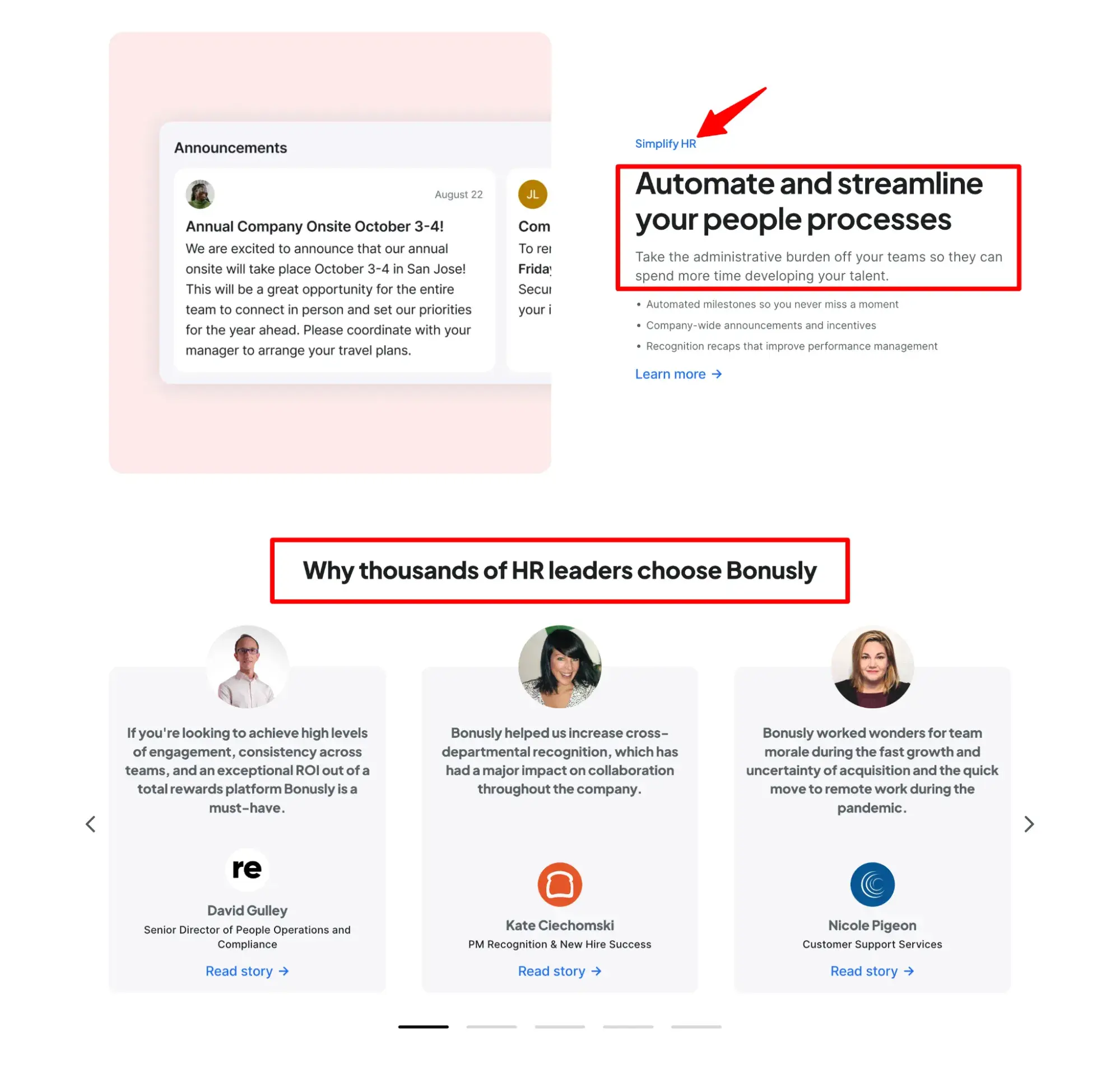
Notice the copy, such as “Take the administrative burden off your teams so they spend more time developing your talent,” speaks directly to a pain point that the buyer persona likely has.
Bonusly also includes testimonials from HR leaders.
This is smart because its marketing website needs to speak directly to the people who have the power to make buying decisions. After all, Bonusly won’t be able to reach its end users without first getting through to its buyers.
But take a look at Bonusly’s Help Center, and you’ll see that it’s catered toward its user personas. This makes sense because it is the users (the people managers, individual contributors, etc.) who will be logging into the product, giving praise, and redeeming rewards.
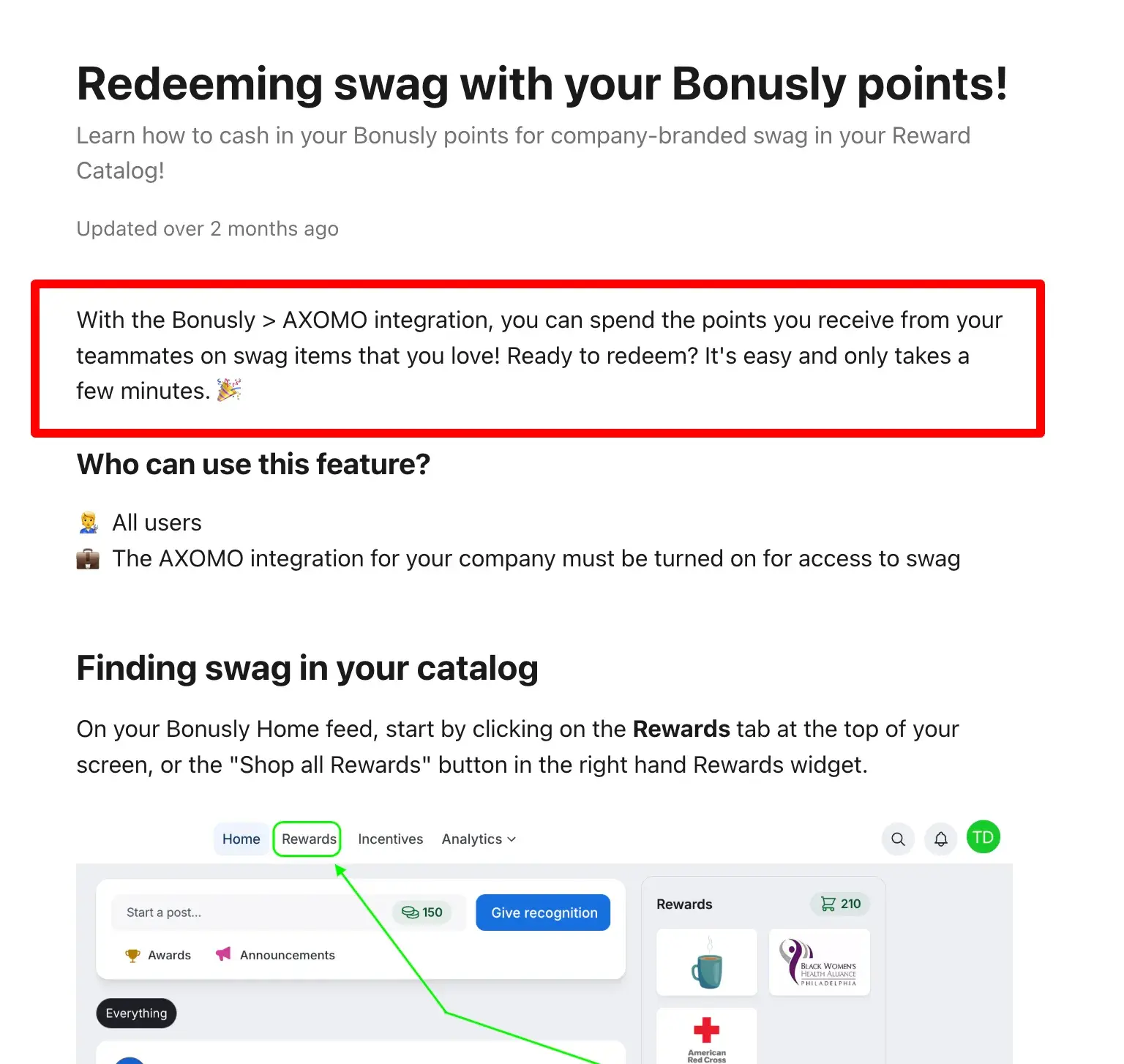
Now that it’s talking to its user personas, Bonusly switches its focus to writing about how easy it is to use the product to redeem rewards. Bonusly switches its tone and language to better meet the needs of its user personas.
This is just one example of how powerful personas really are. They shape everything about your product — the onboarding flows, website UI, and web copy — and about your marketing.
SaaS sales professional Dustin Beaudoin explains it well in a LinkedIn post. He describes three different SaaS companies he worked at and how, at Airplane, a developer-first platform, there was a clear distinction between the buyer persona needs and the user persona needs.
“At Airplane, the buyer was the engineering leader,” Beaudoin writes. “Storytelling helped paint a picture for how they would move the needle on developer productivity, reduce risk, and move faster. In other words, storytelling was key for the broader business case.
“But for the end user, the IC engineer? Not so much. They wanted proof the product worked, that the developer experience was delightful and things fit well in their environment.”
As you can see, the user persona and the buyer persona can be different. And it’s crucial to understand both so you can tailor your product, marketing, and sales to each.
Why UX Personas Matter
Maria Harutyunyan, the co-founder of Loopex Digital, uses UX personas to inform the strategies her teams execute in the business.
Harutyunyan says, “UX personas matter as they represent the people we want to reach with our design. By getting to know their behaviors, desires, needs, and motivations, we can provide the best solutions for them.
“In SEO, especially, understanding our users allows us to create content and strategies that truly meet their unique needs. When we do this well, we see better user engagement, satisfaction, and, ultimately, more conversions.”
Harutyunyan goes on to give an example of a UX persona she used in her agency.
“While working on a project for a client selling eco-friendly products, we discovered through research that one of our key user groups was environmentally-conscious millennials,” says Harutyunyan.
“So, we created a persona named ‘Eco-Friendly Emma,’ a 28-year-old urban dweller passionate about sustainable living. This persona helped guide our SEO strategy, ensuring the content we created resonated with users like Emma.”
Benefits of User Personas
When done well, user personas can work for all kinds of businesses, including yours. Here are four benefits of UX personas.
1. Understand your users.
UX personas represent real people — their likes, dislikes, attitudes, habits, pain points, and more. The descriptive nature of these personas helps designers understand their ideal customers.
They also help designers empathize with the issues their users face and how these issues affect how they interact with the product.
2. Make better product decisions.
User personas highlight what’s important to your users and what they need from your product. This helps designers craft a UX strategy centered around features and solutions that users will appreciate.
Understanding your users’ pain points, goals, and motivations will help you figure out what changes will make the most positive impact on your product’s user experience.
3. Improve user-centered design.
Think of UX personas as a compass that alerts you when you’re making the wrong decisions and steers you back on the right path.
When you consult your user personas often, you won’t design a product based on what you think it should look like. Instead, you’ll design a product tailored to your ideal customers, their capabilities, and their needs.
For example, let’s look at how the same product, a smartphone, can be designed differently based on the user persona. We’ll compare the sales page of Apple’s iPhone against Lively’s Jitterbug.
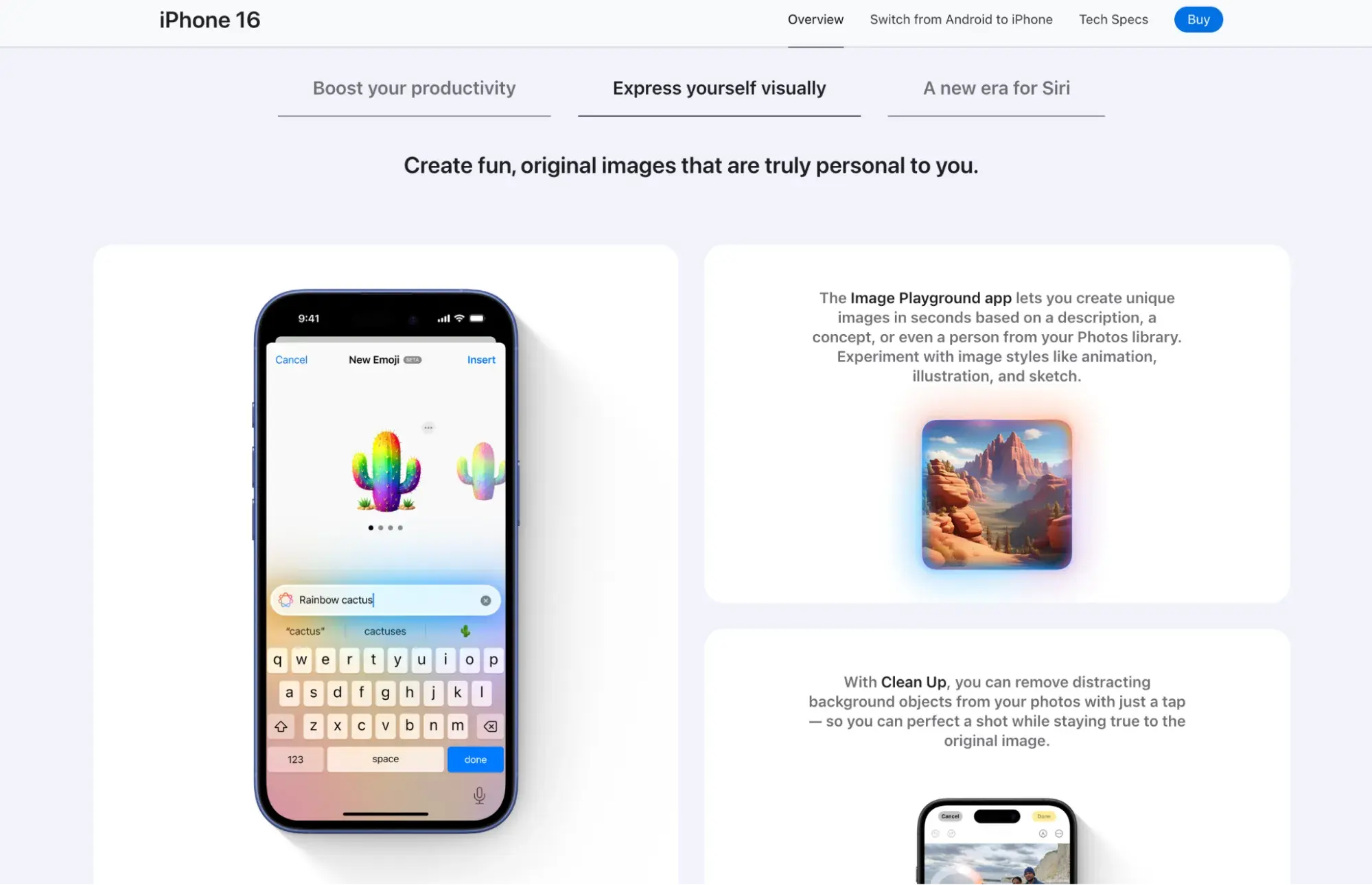

Without even looking at demographics data, I can tell that the iPhone was designed with a user persona in mind who is younger, tech savvy, and motivated by robust and advanced features.
And I can tell that the Jitterbug was designed based on a user persona who is older, isn’t necessarily tech savvy, and is motivated by simplicity and ease of use.
Even the design of the sales pages for each product is based on the user persona. Apple’s iPhone sales page is chock full of animations, full-width images, and even a 3D model that the user can spin around.
On the flip side, Jitterbug’s sales page is shorter, lacks animation, and is overall simpler and easier to digest.
This user-centered design makes all the difference between a product that just looks attractive and one that meets customers’ expectations and fulfills their needs — the latter being crucial for attracting and retaining users.
4. Gain clarity, reducing indecision.
Having clearly defined and well-researched user personas grants your team a level of clarity that makes decisions easier.
For example, instead of fighting over a feature addition, you and your teammates can consult your user persona and quickly tell if that feature is something your persona actually needs.
With this level of clarity, you can align better and move faster.
How to Create a UX Persona
Crafting UX personas is an iterative process. You create them before you start designing and then update them as you gather new data.
Below are the main steps you need to follow to create a foundational UX persona.

1. Conduct user research.
The first step to creating a user persona is to collect data about your users (or prospects). You can do this through qualitative and quantitative research methods.
Qualitative research helps you uncover the motivations, perceptions, and attitudes of your target audience by asking questions or observing them using your product.
Qualitative research methods include:
- User interviews
- Contextual interviews
- Focus groups
- Usability tests
Quantitative research involves numbers. Methods include sending online surveys and analyzing web analytics, including the number of page visitors, time spent on site, and the journey visitors go on before they convert to paying customers.
Surveys can be qualitative or quantitative, and give you deeper insights into the demographics, psychographics, behavioral patterns, challenges, and needs of your customers, which is vital information you need to make the best design decisions.
Pro tip: A true user persona is always based on actual user research. If you don’t have the time or resources to conduct research (or maybe you’re just starting your business and don’t have users yet), you might want to create a “proto persona.”
As Liam, a product marketer at DevSamurai, explains in this forum post on the Atlassian website:
“A proto-persona is a preliminary user profile based on existing knowledge and assumptions. Unlike a full-fledged persona, it isn’t built on extensive user research. Instead, it serves as a springboard for design discussions and early decision-making.”
2. Organize your research.
After conducting your market research, look for commonalities and patterns that allow you to identify different types of users.
This process will vary depending on the kind of research you conducted. With qualitative research, you can use a notes app or a word cloud to visualize data and group users who follow similar themes.
For example, if you notice that a large number of users you spoke to have the same pain point or goal, you can put them in one category.
Or you can analyze the written answers from your survey respondents to find commonalities in the words they use, their interests, hobbies, or personal information, such as age or gender.
For quantitative research, however, you can visualize your data with charts and graphs. These will clearly show you any trends or patterns you should consider as you create your UX persona.
3. Decide on a number of personas.
Now that you have a better understanding of your user groups, identify which ones are the most important and prioritize them throughout the development process.
Ideally, you should have one to four main user groups. For each one, create a clearly defined user persona that’s distinguishable from the others.
You can define each persona by their age, background, technical ability, or even their motivations for using your product.
A great way to distinguish between multiple UX personas is to place them in primary and secondary categories. A primary persona is the most relevant persona that represents users who actually interact with your product.
Secondary personas, on the other hand, are users that may have additional needs that you need to adjust your product to meet. The adjustments, however, should not affect the experience of primary users.
For example, Uber adjusts the visual hierarchy of its website based on its primary and secondary personas.
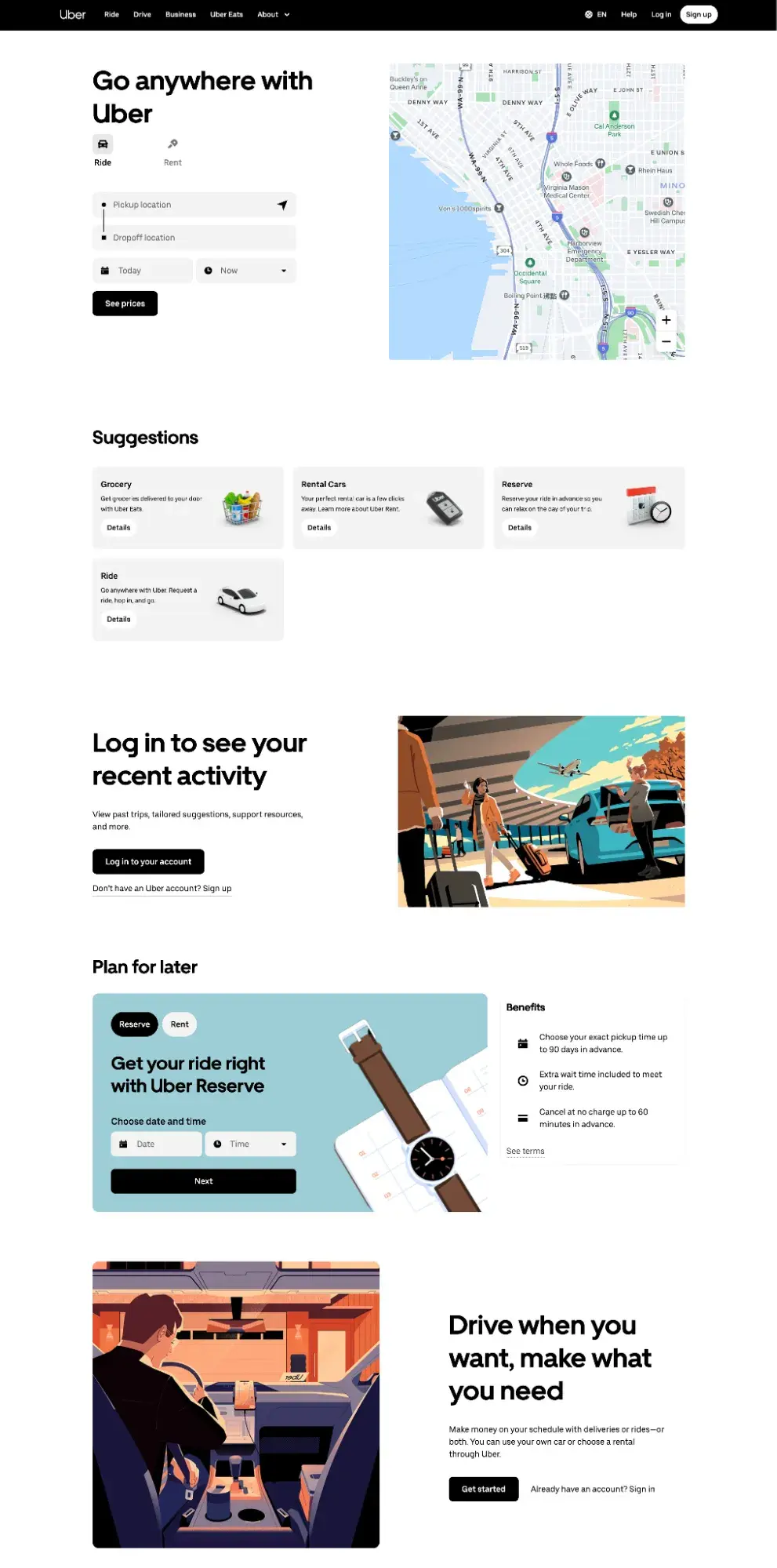
Its primary user persona is riders, so the first thing you see when you land on the website are the fields to enter your pickup and destination addresses, plus “See prices.”
But if you scroll farther down the page, you’ll see copy and a call-to-action aimed at its secondary persona: drivers.
Even the header navigation reflects this hierarchy, with “Ride” coming before “Drive.”
4. Describe your UX persona in detail.
Now it's time to actually create your user persona. Use your research to define the key details about your ideal user as they relate to your product. You can structure your findings in several ways, but ensure you include the following elements:
- Name: Instead of something vague like “User 1,” create a fictional name to make your persona feel more realistic and memorable.
- Image: Use a stock photo or a digital illustration of a person to represent your persona. This helps you empathize with them and makes it easier to imagine them in various product-related use cases.
- Demographics: Specify the age (or age range), family status, employment status, education, background, and technical ability of your persona. This information should be based on research.
- Psychographics: Here, specify the behaviors, pain points, goals, and needs of your persona. This will help you understand your users’ motivations and reasons for using your product.
- A quote: This is a concise statement that sums up the most important thing to your user persona as it relates to your product. Base this quote on research by imagining how your persona would describe themselves if they were a real person.
Pro tip: Put your UX personas in a well-designed document to make it accessible to your team members and other teams that need it.
5. Share (and use) your UX persona(s).
Once you’re satisfied with your user personas, share them with other teams so that other people can understand the users they’re trying to serve.
During the design process, refer back to your personas and include them in discussions about the product.
Before making a critical design decision, ask yourself, “Will this benefit my UX persona?” Doing this helps you put your users first and create a product that meets their needs.
As your product evolves, revisit and tweak your UX personas to keep them current. This may mean adding new personas, scrapping existing ones, or making small changes.
Examples of UX Personas
Now that we’ve covered the process of creating a UX persona, let’s go over some user personas that can inspire your own.
1. GitLab’s Delaney (Development Team Lead)
GitLab is notoriously transparent with the behind-the-scenes of its business, publishing its entire handbook online. In it, there is a detailed list of all 18 of its user personas. Here’s one of them, Delaney (Development Team Lead).

Notice how GitLab lists the following aspects of its persona:
- Job title and alternative job titles
- Job summary
- Motivations
- Frustrations
2. John Michaels, a University Student
Now, I’ll share two personas I made up for a hypothetical healthy food delivery app that delivers to Illinois residents. I chose to add a first and last name for each so they feel more real to me.
Fictional Name
John Michaels
Occupation
Part-time coffee barista, undergrad university student
Demographics
- 20 years old
- Lives in Chicago
- Single, no children
- Has two roommates who work part-time
Goals and Needs
John doesn’t know how to cook. But he’s health-conscious, so instead of eating junk food, he prioritizes eating healthy foods, especially proteins, fruits, and salads, at optimal times throughout the day.
John’s schedule is tight, and he mostly spends time at school or at the coffee shop where he works. Leaving the shop to get food can disrupt his schedule (and pay), so he needs a way to get healthy food without risking those things. His best bet is to order it.
Pain Points
John is on a tight budget, so he needs an app that clearly sorts dishes by price, low to high. He also appreciates a quick and easy payment process and fast delivery.
Personality
“Doing hard things favors no one. If there’s an easy way out, take it. It’s all the same in the end.”
3. Hannah McCoy, a Software Engineer
Fictional Name
Hannah McCoy
Occupation
A full-time software engineer who works from home, a part-time business consultant
Demographics
- 42 years old
- Lives in Chicago with her 44-year-old husband
- Married with two young children
- Has a high income level and a profitable business
Goals and Needs
Ever since she started reading about the lack of quality ingredients in processed foods and juices, Hannah has tried to make time each day to cook healthy meals for her family. However, she just started her consulting business while working a full-time job as a software engineer, so she’s really busy.
Despite her tight schedule, Hannah refuses to give her family junk food and processed meals. She needs a reliable restaurant that can deliver healthy foods in bulk to her Chicago residence.
Pain Points
Most food delivery apps that Hannah has checked out don’t offer healthy salad bowls, and the few that have salads on their menu don’t deliver in bulk. Hannah would appreciate a restaurant that can deliver healthy meals that can last at least four days.
She’d also love for it to deliver pre-prepared veggies so she won’t have to go to the grocery store often.
Personality
“Doing everything all at once saves time and stress, especially if you’re a busy bee.”
Tips for Creating a UX Persona
As you create your user persona, here are some tips you should keep in mind.
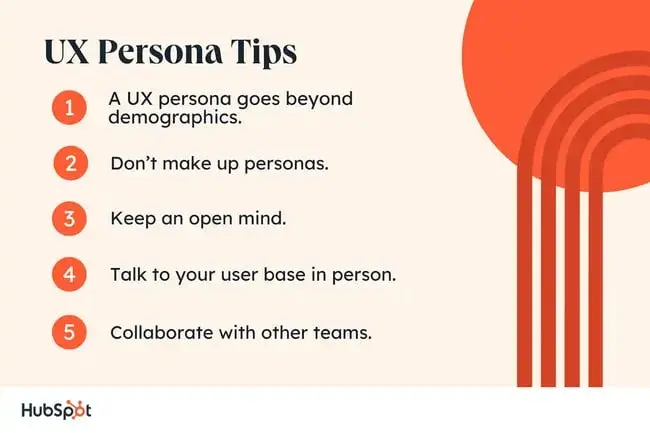
1. A UX persona goes beyond demographics.
While demographics are an important part of creating a UX persona, it shouldn’t be your entire persona. UX personas should be based on your users’ behaviors, goals, and motivations, rather than their age and job title.
Knowing that your ideal user is a middle-aged full-time project manager who runs a side hustle is useless if you don’t know what’s stopping them from subscribing to your product.
What’s better? Knowing that your ideal user is highly motivated by convenience and would sign up for your software if it integrated with his Apple Watch.
2. Don’t make up personas.
It can be tempting to just whip up a UX persona based on your (or your superiors’/colleagues’) understanding of your product and the market.
But this can be detrimental because you’ll end up creating a product that’s for you (or the person whose ideas you’re basing your persona on) and not for your users.
Good user personas should be based on real insights you get from communicating with your target audience.
Take it from Logan Toskey, VP of Sales at Instinct Science, who calls “trying to learn about the buyer from the sales team” the “biggest mistake” of his first 30 days at one of his sales jobs.
Instead, he learned that spending time with actual people who represented his buyer personas helped him gain user understanding so he could actually help them through his product.
As he writes on LinkedIn, “Spend more time out of the gate with the personas you sell to versus spending all your time with the sales team.”
3. Keep an open mind.
This ties nicely with the previous point. During your research, you might be surprised by the answers your target audience is providing, especially if they don’t coincide with the company narrative. In cases like this, you need to keep an open mind.
“When creating UX personas, researchers should avoid bias,” says Leizel Laron, the UI/UX designer at Exaweb. “It is important to refrain from creating demographics that favor the product, as doing so can result in unreliable feedback and outcomes.”
You’re not the customer. Take a step back and let user insights guide you.
4. Talk to your user base in person.
Sending out online surveys for your target audience is a great way to get detailed answers to your questions.
But if you want to get a deeper knowledge of your users, your best bet is to speak directly with some of your actual customers (or site visitors) face-to-face or via video chat.
This helps you get raw, unedited answers you can use to expand on what you have already built.
Pro tip: Pay your participants. It can broaden the pool and boost your response rates. Plus, it’s a nice way to show users you appreciate their time and effort.
“As a rule of thumb, never pay participants with cash. It’s too hard to track,” says Indeed UX research manager Kathryn Brookshier in an article published on Medium.
She goes on to write, “Instead, consider PayPal or a gift card from Visa, Amazon, a grocery store, or your own business. It’s easy to store in the office and track payments to participants so that everyone is in agreement that payment was received.”
5. Collaborate with other teams.
While user personas are mostly used by the design team, other departments, like marketing, may need to reference them while creating campaigns and business strategies. So make your UX persona(s) available to them.
As Daniel Chabert, the CEO and co-founder of PurpleFire, puts it: “Encourage cross-functional collaboration, including input from design, development, and marketing teams, to build a unified understanding of user needs.”
Create effective UX personas.
UX personas turn the abstract concept of a customer into a (semi) real person with preferences, emotions, and personality. Because of this, design teams have something tangible they can refer to when making product decisions.
These personas help the design team avoid generalizations and focus on the target audience instead, allowing them to create user-centric interfaces and tailor the product features to meet real people’s specific needs.
So, the next time you’re designing a product, do away with the vague abstractions and create UX personas to help you think of your users as real people. Because, after all, they are.
Editor's note: This post was originally published in October 2023 and has been updated for comprehensiveness.
User Experience
.png?width=112&height=112&name=Image%20Hackathon%20%E2%80%93%20Square%20(10).png)

.png)

![How to become a UX designer, a step-by-step guide [expert tips]](https://53.fs1.hubspotusercontent-na1.net/hubfs/53/become-a-ux-designer-1-20240731-321437.webp)


![How to Add a Parallax Scrolling Effect to Your Website [Examples]](https://53.fs1.hubspotusercontent-na1.net/hubfs/53/scroll-Aug-11-2023-05-24-08-8793-PM.png)

![20 UX Design Examples Hand-Picked by Experts [With Analysis]](https://53.fs1.hubspotusercontent-na1.net/hubfs/53/ux-design-examples-1-20250404-8425368.webp)
